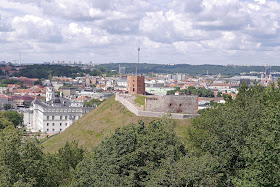The Cathedral
We have already had a fine walk around part of Vilinius's large Old Town (from the Gates of Dawn to the University) and today's mission was to see the rest of it. We set off from our hotel and walked down Town Hall Square and into Pilies gatve (street, abbreviated to g.). This is the view looking down towards the Cathedral.
We were delighted to find on the right, just before Literatu g., the first art nouveau house we had seen in the city. It looks as though renovation is not far from being complete.
Literatu g. is marked on the map we got from the Tourist Information Office as one of the top ten things to see, but it is not mentioned in our guidebook. It turns out to house two sections of wall celebrating Lithuanian writers and authors linked to Lithuania in the form of small pieces of art honouring each writer. Two larger tablets on the right provide a key to who did each work and who it commemorates. It's rather a nice idea and it reminds me of the strong sense Lithuanians have of being a cultured people.
Next on the Top Ten list is Uzupis. This is also new to us bit we head off to find it, crossing the rather lovely Vilnia river (which doubtless gives the city its name).
Heading through a quiet corner of the city we reach a delightful small square, quite Italian in feeling, to find a column topped by a wonderful statue of an angel blowing a trumpet.
It was erected in 2002 and was the work of sculptor Romas Vilčiauskas. It turns out that Uzupis is the artists' quarter and has declared itself an independent republic.
From here we head along to the fantastic ensemble of St Anne's church and the Bernadine church. The brick St Anne's is externally a gothic masterpiece with ogive shapes on both the sides and especially the facade. Napoleon is said to have been so delighted by it that he wanted to take it back to France with him. The Baroque interior comes as a shock however.
The facade looks as though it could do with a thorough restoration. The Bernadine church was built in the gothic style and consecrated in 1516. Baroque elements were added later. In the vast interior there are frescoes discovered only in 1981.
Out tourist map now directs us to the Bernadine Gardens, a pleasant public park with a nice view up to the Hill of the Three Crosses which I had intended to be the end point of this walk. The Hill of Three Crosses is a symbol of Vilnius. The original three crosses were placed there in the 16th century to commemorate the murder of some Franciscan friars by pagans. The monument was destroyed by the Soviet in the 1950s and the current replica is part of the reassertion of national identity.
We suddenly realised that we had arrived at a bridge over the river Vilnia and that we could walk along the opposite bank then climb up to the Hill, making the walk more circular. Off we went.
It was a very pleasant walk involving quite a steep climb up wooden steps, some of which were broken. There is a lovely view from the top looking over to the remains of the Upper Castle (1419) and then down to the Lower Castle with the Cathedral behind it.
We walk down the other side, past an arena where a folk dancing festival for kids is taking place, to cross the river again, just where it joins the much larger Neris river. Eschewing the funicular, we climb up a steep stony path to reach the Upper Castle.
Naturally we then climb to the top and enjoy a superb view in all directions, but especially over the City. This picture shows Pilies g. snaking its way uphill, past the tall free-standing tower of St John's church, towards the neoclassical Town Hall and the pink St Casimir's church.
There is also a good view downwards to the Lower Castle. I didn't remember this at all and it seems that most of it was demolished in the 19th century, having long been in a ruinous state. It was only decided at the start of the 21st century to rebuild it.
We walked down past the Lower Castle to enjoy a fabulous view of the wonderful bell tower of the 18th century Cathedral. It was designed by Laurynas Stuoka-Gucevičius, who was also responsible for the Town Hall.
Finally, we walk back up Pilies g., taking in the free-standing bell tower of St John's church on the way.
Conditions: warm and sunny.
Distance: about 3.5 miles.
Rating: five stars.
















No comments:
Post a Comment